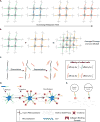Bottom-up approaches in synthetic biology and biomaterials for tissue engineering applications
- PMID: 29552703
- PMCID: PMC6041164
- DOI: 10.1007/s10295-018-2027-3
Bottom-up approaches in synthetic biology and biomaterials for tissue engineering applications
Abstract
Synthetic biologists use engineering principles to design and construct genetic circuits for programming cells with novel functions. A bottom-up approach is commonly used to design and construct genetic circuits by piecing together functional modules that are capable of reprogramming cells with novel behavior. While genetic circuits control cell operations through the tight regulation of gene expression, a diverse array of environmental factors within the extracellular space also has a significant impact on cell behavior. This extracellular space offers an addition route for synthetic biologists to apply their engineering principles to program cell-responsive modules within the extracellular space using biomaterials. In this review, we discuss how taking a bottom-up approach to build genetic circuits using DNA modules can be applied to biomaterials for controlling cell behavior from the extracellular milieu. We suggest that, by collectively controlling intrinsic and extrinsic signals in synthetic biology and biomaterials, tissue engineering outcomes can be improved.
Figures





Similar articles
-
Engineering Synthetic Gene Circuits in Living Cells with CRISPR Technology.Trends Biotechnol. 2016 Jul;34(7):535-547. doi: 10.1016/j.tibtech.2015.12.014. Epub 2016 Jan 22. Trends Biotechnol. 2016. PMID: 26809780 Review.
-
Synthetic circuits, devices and modules.Protein Cell. 2010 Nov;1(11):974-8. doi: 10.1007/s13238-010-0133-8. Epub 2010 Dec 10. Protein Cell. 2010. PMID: 21153514 Free PMC article. Review.
-
Synthetic biology: integrated gene circuits.Science. 2011 Sep 2;333(6047):1244-8. doi: 10.1126/science.1207084. Science. 2011. PMID: 21885772 Free PMC article. Review.
-
Machine learning for synthetic gene circuit engineering.Curr Opin Biotechnol. 2025 Apr;92:103263. doi: 10.1016/j.copbio.2025.103263. Epub 2025 Jan 27. Curr Opin Biotechnol. 2025. PMID: 39874719 Review.
-
Synthetic biology: an emerging engineering discipline.Annu Rev Biomed Eng. 2012;14:155-78. doi: 10.1146/annurev-bioeng-071811-150118. Epub 2012 May 7. Annu Rev Biomed Eng. 2012. PMID: 22577777 Review.
Cited by
-
Only kosmotrope anions trigger fibrillization of the recombinant core spidroin eADF4(C16) from Araneus diadematus.Protein Sci. 2023 Dec;32(12):e4832. doi: 10.1002/pro.4832. Protein Sci. 2023. PMID: 37937854 Free PMC article.
-
Learning from BMPs and their biophysical extracellular matrix microenvironment for biomaterial design.Bone. 2020 Dec;141:115540. doi: 10.1016/j.bone.2020.115540. Epub 2020 Jul 27. Bone. 2020. PMID: 32730925 Free PMC article. Review.
-
Design and development of engineered receptors for cell and tissue engineering.Curr Opin Syst Biol. 2021 Dec;28:100363. doi: 10.1016/j.coisb.2021.100363. Epub 2021 Aug 3. Curr Opin Syst Biol. 2021. PMID: 34527831 Free PMC article.
-
Genetic circuits to engineer tissues with alternative functions.J Biol Eng. 2019 May 3;13:39. doi: 10.1186/s13036-019-0170-7. eCollection 2019. J Biol Eng. 2019. PMID: 31073328 Free PMC article. Review.
-
Rosa26 docking sites for investigating genetic circuit silencing in stem cells.Synth Biol (Oxf). 2020 Aug 19;5(1):ysaa014. doi: 10.1093/synbio/ysaa014. eCollection 2020. Synth Biol (Oxf). 2020. PMID: 33195816 Free PMC article.
References
-
- Deans TL, Cantor CR, Collins JJ. A tunable genetic switch based on RNAi and repressor proteins for regulating gene expression in mammalian cells. Cell. 2007;130(2):363–372. - PubMed
-
- Fitzgerald M, et al. Adoption of the Q Transcriptional System for Regulating Gene Expression in Stem Cells. ACS Synth Biol. 2017 - PubMed
-
- Gardner TS, Cantor CR, Collins JJ. Construction of a genetic toggle switch in Escherichia coli. Nature. 2000;403(6767):339–342. - PubMed
MeSH terms
Substances
Grants and funding
LinkOut - more resources
Full Text Sources
Other Literature Sources

